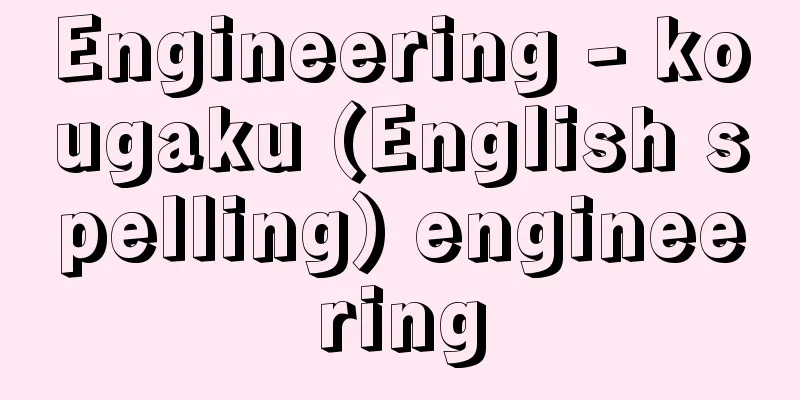Engineering - kougaku (English spelling) engineering

|
The word "engine" comes from the Latin word for "to invent," and an "engineer" was a professional who designed and used military equipment and facilities, such as crossbows, pontoons, and attack towers. The Englishman Smeaton, who was respected by his fellow professionals, advocated civil engineering, and in 1771, he brought together professionals who worked on streets, water supplies, canals, and other areas that benefited ordinary citizens, rather than on military engineering. In 1818, the world's first civil engineering society, the Institution of Civil Engineering, was formed in England, and defined engineering as "the art of controlling large sources of power in nature so that they are useful to humans." Thus, this society represented all engineering, but civil engineering dominated, as seen in the fact that Telford, who built canals, bridges, and roads, was the first president. In Japan, it is called the Japan Society of Civil Engineers. Subsequently, with the development of steam locomotives, the Institution of Mechanical Engineers, with G. Stephenson as its first president, spun off from this society and became independent in 1847. Furthermore, with the development of telegraph equipment, the Telegraph Engineering Society, with W. Siemens as its first president, was founded in 1871, but with the rapid development of electric power equipment, it changed its name to the Electrical Engineering Society in 1881. In Japan, the origin of engineering education was the Imperial College of Engineering, which was developed and reorganized from the Engineering Bureau within the Ministry of Public Works at the beginning of the Meiji period, and departments such as civil engineering, mechanical engineering, electrical engineering, architecture, mining, chemistry, metallurgy and shipbuilding have basically been passed down to the present day, and its graduates went on to form the Japan Society of Engineering. The specialization of engineering progressed further in the 20th century, with the birth of fields such as chemical engineering, materials engineering, and nuclear engineering, and new boundary areas with the humanities and social sciences such as ergonomics, industrial engineering, social engineering, educational engineering, urban engineering, environmental engineering, and information engineering, which apply engineering methods to the human and social sectors beyond the labor means systems such as machines, equipment, and facilities. Engineering methods are also applied to the natural sciences, and are expanding into border areas such as biotechnology, space engineering, and marine engineering, leading to the engineering of science, agriculture, and medicine, and the science of engineering. However, engineering has become too fragmented and specialized, and there are attempts to unify it from an educational standpoint, such as basic engineering, which attempts to reorganize it from the basic theories of natural science, and general introductions to engineering, which introduce humanities and social science perspectives to engineering through the history of technology. There is also discussion of the distinction between engineering and technology, which is an adjacent concept, and there is a definition that engineering is the study of industrial technology, but if we trace the etymology and origins of the word, we can see that there is a difference in historical nature between engineering, which is a professional specialty, and technology, which is a liberal arts specialty. [Toshio Yamazaki] [Reference] |Source: Shogakukan Encyclopedia Nipponica About Encyclopedia Nipponica Information | Legend |
|
語源の「エンジン」はラテン語の「考案」に由来し、「エンジニアengineer」とは、軍事用具・施設、たとえば弩砲(どほう)、浮き橋、攻撃塔などを設計・使用する職業人のことであった。その職業人仲間から尊敬されたイギリス人スミートンは、市民工学civil engineeringを提唱し、1771年、これまでの軍事工学でなく、街路・給水・運河など一般市民に役だつ職業人を結集した。1818年世界最初の市民工学会Institution of Civil Engineeringがイギリスで結成され、工学を「自然にある大きな動力源を人間に役だつように支配する術」と定義した。したがって、この学会は全工学を代表していたが、運河・橋・道路を建設したテルフォードが初代会長に就任したように土木工学が主流を占めていた。日本では土木学会とよばれる。 その後、蒸気機関車が発達し、この学会からG・スティーブンソンを初代会長とする機械工学会が1847年に分化、独立した。さらに電信機器の発達からW・シーメンズを初代会長とする電信工学会が1871年に創立したが、電力機器の急速な発達により1881年に電気工学会と改称した。日本では明治の初め工部省内の工学寮が発展改組した工部大学校が工学教育の起源となり、土木・機械・電気・建築・鉱山・化学・冶金(やきん)・造船などの学科が今日まで基本的に受け継がれ、その卒業生が日本工学会を結成した。 工学の専門分化は20世紀にさらに進み、化学工学、材料工学、原子力工学などが生まれ、機械・装置・施設などの労働手段体系以外の、人間・社会部門にも工学の方法を適用する人間工学・経営工学・社会工学・教育工学・都市工学・環境工学・情報工学など、人文・社会科学との新しい境界領域を設定している。 工学の方法は自然科学部門にも適用され、生物工学・宇宙工学・海洋工学などの境界領域に次々と進出し、理学・農学・医学の工学化、工学の理学化を招いている。しかし、あまりにも細分化、専門化された工学を教育的立場から統一し、自然科学の基礎理論から再編成しようとする基礎工学、技術史によって工学に人文・社会科学的視点を導入する工学概論の試みがなされている。また工学の隣接概念である技術学(テクノロジー)との区別が論じられ、工学とは工業技術学であるという定義もみられるが、語源と源流をたどれば、工学は職業専門的、技術学は一般教養的な歴史的性格の差異をもつことがわかる。 [山崎俊雄] [参照項目] |出典 小学館 日本大百科全書(ニッポニカ)日本大百科全書(ニッポニカ)について 情報 | 凡例 |
Recommend
gṛha (English spelling) grha
…On the other hand, the German word Haus lost its...
Ophisurus macrorhynchus (English spelling) Ophisurus macrorhynchus
…None of the species are considered edible, and a...
Kalimba (English spelling)
An African folk instrument. It has a resonating bo...
Acute lymphangitis - Acute lymphangitis
… Lymphangitis can be acute or chronic, and acute...
political arithmetic
...Quantitative biometry also includes applicatio...
Indian rat flea - Indian rat flea
... House mice are often infested with the Japane...
Trier, W.
…In the 1920s, KF von Freyhold and Elsa Eisgruber...
glacial eustasy
...However, the global sea level changes seen in ...
She De-hui (English name)
[Born] February 11, 1864. [Died] April 11, 1927. C...
Kitatama District
...In 1872, the Tama region, which was under the ...
MacLennan, Hugh
Born: March 20, 1907, Grace Bay [Died] November 7,...
Morgan, WW (English spelling) MorganWW
...This is called the absolute luminosity effect....
National Railway Niigata Struggle - National Railway Niigata Struggle
In the spring offensive of 1957, Kokuro (National ...
Phylogenetic tree
A tree-like representation of the relationships b...
Emphyteusis - emphyteusis
It refers to the right to use someone else's ...









